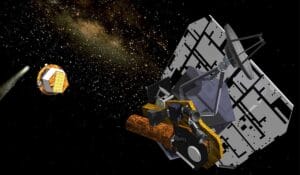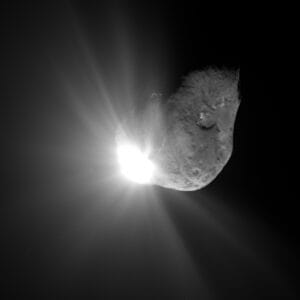I caught up this week with one of the few TV shows I’m watching — the newest Star Trek series, Enterprise.
The episode I saw this week had the ship come across a comet. A landing party went down to it, blasted out a crater, and took a core sample. (Nitpick for the producers: an 80km comet* doesn’t produce full Earth gravity! Sheesh!)
 Anyway, the entire concept is so much like real life, I have to mention it: the Deep Impact Mission just passed its critical design review.
Anyway, the entire concept is so much like real life, I have to mention it: the Deep Impact Mission just passed its critical design review.
You may know I used to work at NASA’s Jet Propulsion Laboratory. Deep Impact is a JPL mission that will slam a probe into comet Tempel 1 on July 4, 2005. Mission planners expect the resulting crater will be about 90m wide and 30m deep (the comet itself is about 3km, or 1.9 miles around), yet even that impact isn’t expected to change the comet’s orbit at all**!
A spacecraft will be stationed 300 miles away and will “observe the impact, the ejected material blasted from the crater, and the structure and composition of the crater’s interior.”
Best of all, the impact will be visible from Earth, even with fairly small telescopes (and, of course, the pictures will be shown on the ‘net). Very, very cool — and considerably more interesting than the fictional concept of drilling a core sample!
Building History
When I worked at JPL, I really liked going down to the “high bay” where they build space probes. By weird coincidence, Deep Impact isn’t being built there, but instead by a contractor: Ball Aerospace in Colorado, about 5 miles away from where I now live. The project has a great web site with all sorts of details.

*When I said this in the free edition, I got lots of mail saying that size doesn’t determine gravity. Yes, I know; gravity is a function of mass, which is determined by composition and the amount of material present — which is a function of size. Bottom line: an 80km body cannot produce full Earth gravity.
**“No orbital change at all” isn’t 100% scientifically accurate, of course.
Don Yeomans, JPL’s Supervisor for the Solar System Dynamics Group and Manager of NASA’s Near-Earth Object Program Office, puts it this way: “The collision with comet 9P/Tempel 1 takes place near the comet’s perihelion point and at a relative velocity of 10.2 km/s. The 350 kg impactor will impart a very modest 0.0001 mm/s velocity change in the comet’s orbital motion and by so doing decrease the comet’s perihelion distance by 10 meters and decrease its orbital period by far less than a second of time. This is to be compared to a change of some 378 billion meters in the comet’s perihelion distance due to the passage by Jupiter in 2024.”
That’s close enough to “no change at all” for me.
Mission Success

“We hit it just exactly where we wanted to,” Yeomans said on July 5, 2005. The resulting crater was about 100 m wide and up to 30 m (98 ft) deep.
After the impact, the spacecraft was reprogrammed for an extended mission to fly by other comets. On November 4, 2010, it returned images from comet Hartley 2, and it observed Comet Garradd (C/2009 P1) from February 20 to April 8, 2012. In February 2013, Deep Impact observed Comet ISON. The comet remained observable until March 2013.
However, a plan to visit asteroid (163249) 2002 GT on January 4, 2020, failed, as NASA lost contact with the spacecraft on September 3, 2013, more than 8 years after the end of its primary mission. Attempts to reestablish communications failed after NASA determined it was unlikely the spacecraft’s antennas were pointed toward Earth, or it solar panels were pointed toward the sun.
– – –
Bad link? Broken image? Other problem on this page? Use the Help button lower right, and thanks.
This page is an example of my style of “Thought-Provoking Entertainment”. This is True is an email newsletter that uses “weird news” as a vehicle to explore the human condition in an entertaining way. If that sounds good, click here to open a subscribe form.
To really support This is True, you’re invited to sign up for a subscription to the much-expanded “Premium” edition:
Q: Why would I want to pay more than the minimum rate?
A: To support the publication to help it thrive and stay online: this kind of support means less future need for price increases (and smaller increases when they do happen), which enables more people to upgrade. This option was requested by existing Premium subscribers.
